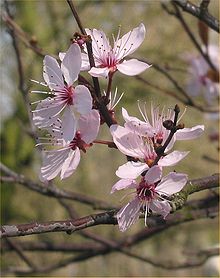Blood plum
As Blutpflaume one red-leaved referred varieties of cherry plum ( Prunus cerasifera ) and red-leaved varieties of intersections incurred by the cherry plum with related species. The plants often used as ornamental trees are mostly of the 'Nigra' variety. The blood plum probably originated from a cherry plum plant brought to France from Persia in 1880.
description
The blood plum grows, similar to the cherry plum, as a larger shrub or as a small to medium-high tree . It is a maximum of 15 m high. The growth habit of the plants cultivated as ornamental trees can easily be influenced by specific pruning. Both shrub-shaped plants as well as half or high stems are available on the market.
In contrast to the cherry plum, the leaves are colored carmine red to black-red. Older varieties show a vivid red color when the leaves shoot in spring, which turns green later in the year; Newer cultivars aim to give the leaves an intense color all year round.
The flowers of the blood plum unfold at the same time as the leaves (April – May), in contrast to the pure white color of the flowers of the cherry plum, they are either white in color with pink stamens or pink in color.
After the plant has bloomed from the end of April to the beginning of May, edible and tasty cherry fruits (stone fruits) develop. They look like normal plums, but are slightly smaller. The seeds contained in the core are poisonous.
sorts
Various types of common blood plums and a weak dwarf form are available in tree nurseries and garden centers:
- ' Pissardii' , synonyms: 'Atropurpurea', Prunus pissardii Carrière
- This form was first introduced to France by Pissard from Persia around 1880, all other blood plums are the result of breeding from this variety. Today it is rarely available in stores. The leaves are larger than the type; they are red-brown in color; however, the tint fades a little over the course of the year. The two centimeter wide flowers are white with at most a very slight shade of pink; they appear before the leaves in April. The purple fruits are three centimeters tall and spherical.
- ' Hessei'
- Around 1906 the Hesse tree nursery from Weener offered this shrub-like growing variety, it can still be found on the market today. It is said to be a trichimera, i.e. a plant whose tissue is composed of three genetically different plants (Pohlheim F. 1970: Prunus pissardii 'Hessei' - a trichimera. - Flora 159: 435-449).
- ' Woodii'
- This variety can be traced back to 1910, when it was sold by the Späth tree nursery . It is practically indistinguishable from the 'Nigra' variety.
- ' Nigra'
- This shape, which was introduced from the USA around 1916, has deep red-black leaves that keep their rich hue in autumn. The flowers are pink. Most of the plants known as "blood plums" belong to this variety.
- ' Trailblazer' , synonym: 'Hollywood'
- A cross between Prunus salicina 'Shiro' and Prunus cerasifera 'Pissardii', originated in the USA in 1947, commercially available from 1954 and still widely available today, is characterized by large, tasty fruits, hence also called "large-fruited blood plum"
- Prunus x cistena
- The slow-growing dwarf blood plum ( Prunus × cistena ) is a hybrid of Prunus pumila and Prunus cerasifera 'Pissardii'. The intersection was founded in 1906 by Dr. Niels E. Hansen in the USA, the plants came on the market in 1910.
Web links
- PPP index. Plant buying guide for Europe . Ulmer Verlag, online database, for a fee
- Jacobson, AL: Purpleleaf Plum Trees .

